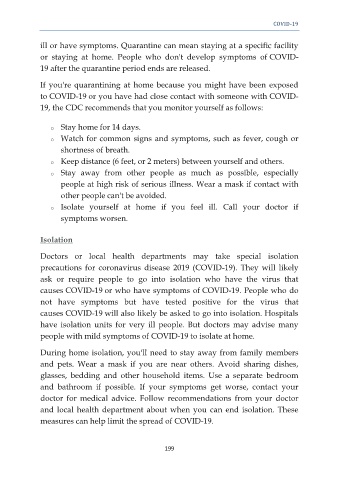Page 230 - fourth year book
P. 230
COVID-19
ill or have symptoms. Quarantine can mean staying at a specific facility
or staying at home. People who don't develop symptoms of COVID-
19 after the quarantine period ends are released.
If you're quarantining at home because you might have been exposed
to COVID-19 or you have had close contact with someone with COVID-
19, the CDC recommends that you monitor yourself as follows:
o Stay home for 14 days.
o Watch for common signs and symptoms, such as fever, cough or
shortness of breath.
o Keep distance (6 feet, or 2 meters) between yourself and others.
o Stay away from other people as much as possible, especially
people at high risk of serious illness. Wear a mask if contact with
other people can't be avoided.
o Isolate yourself at home if you feel ill. Call your doctor if
symptoms worsen.
Isolation
Doctors or local health departments may take special isolation
precautions for coronavirus disease 2019 (COVID-19). They will likely
ask or require people to go into isolation who have the virus that
causes COVID-19 or who have symptoms of COVID-19. People who do
not have symptoms but have tested positive for the virus that
causes COVID-19 will also likely be asked to go into isolation. Hospitals
have isolation units for very ill people. But doctors may advise many
people with mild symptoms of COVID-19 to isolate at home.
During home isolation, you'll need to stay away from family members
and pets. Wear a mask if you are near others. Avoid sharing dishes,
glasses, bedding and other household items. Use a separate bedroom
and bathroom if possible. If your symptoms get worse, contact your
doctor for medical advice. Follow recommendations from your doctor
and local health department about when you can end isolation. These
measures can help limit the spread of COVID-19.
199

